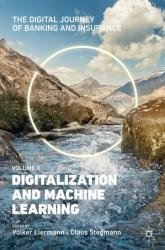The Digital Journey of Banking and Insurance, Volume II: Digitalization and Machine Learning
- Добавил: literator
- Дата: 27-10-2021, 20:17
- Комментариев: 0
 Название: The Digital Journey of Banking and Insurance, Volume II: Digitalization and Machine Learning
Название: The Digital Journey of Banking and Insurance, Volume II: Digitalization and Machine LearningАвтор: Volker Liermann, Claus Stegmann
Издательство: Palgrave Macmillan
Год: 2021
Страниц: 361
Язык: английский
Формат: pdf (true), epub
Размер: 51.1 MB
This book, the second one of three volumes, gives practical examples by a number of use cases showing how to take first steps in the digital journey of banks and insurance companies. The angle shifts over the volumes from a business-driven approach in “Disruption and DNA” to a strong technical focus in “Data Storage, Processing and Analysis”, leaving “Digitalization and Machine Learning Applications” with the business and technical aspects in-between. This second volume mainly emphasizes use cases as well as the methods and technologies applied to drive digital transformation (such as processes, leveraging computational power and Machine Learning models).
These are the two most significant sources of insurance fraud and they basically come down to an information asymmetry problem. This is one of the biggest challenges in avoiding insurance fraud—decreasing the information asymmetry between the insurer and the insured. This is often called “costly state verification” and means that verifying the information the insured individual provides to the insurer comes at a cost. Machine learning is one tool to decrease these costs. Unfortunately, machine learning requires good data quality. But, luckily, insurers have spent the past decade or so increasing the data availability, for example, for car insurance contracts. In the more general case, we should take some further steps to clean the data, such as removing duplicate observations, removing attributes with very few unique values, and standardization for numerical values. The following analysis is implemented by using the R and machine learning open-source platform H2O. As a supervised learning model, the algorithms usually learn on a labeled dataset and the label is the target that needs to be predicted. In our example, the data samples are already labeled as “Fraud” or “Regular Claim.” In contrast, labeling is not necessarily required for unsupervised learning models. In this case, the algorithms assume that most of the claims are not fraudulent and learn to inherit structure from the normal data. The anomalies/outliers, which are suspicious by differing significantly from the normal structure, are identified as anomalous.
Quantum computing is a groundbreaking technology. Practical implementation is not at hand for every institution, but it is within sight and expected to become a standard practice in the coming decade. The way algorithms are structured is significantly different from the classical (binary) programming paradigm. The differing programming paradigm is a challenge for all nontheoretical physicists and some aspects might demand different thinking even for mathematicians. The hurdle is even higher for all others, but a basic knowledge about the idea behind quantum computers is again the key to identifying the relevant use cases, helping to improve the business. Quantum computing will contribute to scenario generation and analysis, making it a powerful tool for all risk managers and controllers.
Contents:
Use Cases
Use Case: Optimization of Regression Tests—Reduction of the Test Portfolio Through Representative Identification
Use Case - Nostro Accounts Match
Use Case - Fraud Detection Using Machine Learning Techniques
Use Case: NFR - HR Risk
Sentiment Analysis for Reputational Risk Management
Use Case: NFR - Using GraphDB for Impact Graphs
High-Performance Applications
Distributed Calculation Credit Portfolio Models
BSDS: Balance Sheet Dynamics Simulator
Dynamic Dashboards
High-Performance Applications
Quantum Computing
Post-quantum Secure Cryptographic Algorithms
Quantum Technologies
Categorical Quantum Theory
Process and Process Optimization
Processes in a Digital Environment
Process Mining
Hyperautomation (Automated Decision-Making as Part of RPA)
RPA Use Case - “IFRS 9/SPPI”
Open Source
Open-Source Software
Summary
Скачать The Digital Journey of Banking and Insurance, Volume II: Digitalization and Machine Learning
Внимание
Уважаемый посетитель, Вы зашли на сайт как незарегистрированный пользователь.
Мы рекомендуем Вам зарегистрироваться либо войти на сайт под своим именем.
Уважаемый посетитель, Вы зашли на сайт как незарегистрированный пользователь.
Мы рекомендуем Вам зарегистрироваться либо войти на сайт под своим именем.
Информация
Посетители, находящиеся в группе Гости, не могут оставлять комментарии к данной публикации.
Посетители, находящиеся в группе Гости, не могут оставлять комментарии к данной публикации.
